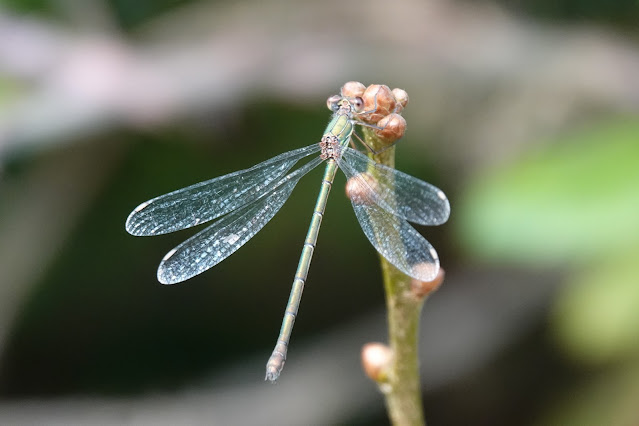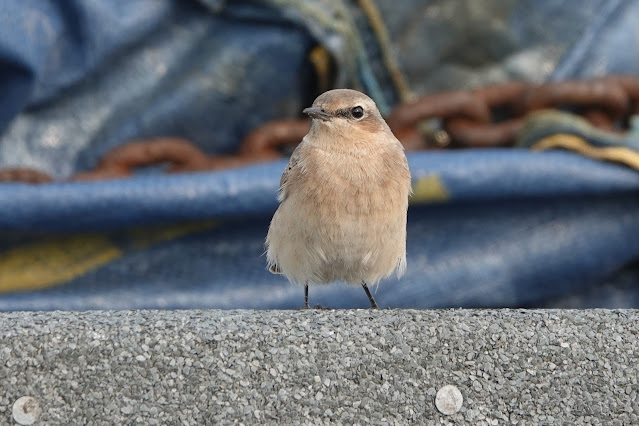I trapped on the night of the 5th in the hope of attracting
some migrant moths incoming with the host of passerines also on their way. The trap was not heaving but there were many
Large Yellow Underwings jammed in the egg boxes and I was pleased that I had
paid attention to Antony the night before and picked up a Pearly Underwing
amongst them with a tiny but obvious white spot either side of the head. A Rush Veneer and Angle Shades were also new
in migrants. A single Red Admiral was also
in the trap and it became apparent during the day that many people had caught
them overnight as they too migrated across the North Sea in the dark. Two Old Ladies squabbled in the bottom and it
was my first night with multiple Box-tree Moths.
 |
| Pearly Underwing |
 |
| Rush Veneer |
The morning of the 6th saw me getting frustrated
again down at Pakefield Beach where once again I completely failed to pick up
any of the Manxies and Sooties that I know flew past me going north. I saw other birds with 93 Gannets, Arctic Skua,
two Scoter, Teal and Shoveler, 12 Sandwich Terns and Guillemot but not one
Shearwater did I see!
Twelve Meadow Pipits were on the beach having arrived
overnight and Large Whites and Red Admirals were still arriving.
As was predicted migrants began arriving mid afternoon and
much as last Saturday spots all around the East Anglian coast started picking
up multiple Wheatears, Whinchats, Redstarts and both Flycatchers. Once again I resisted driving to go and look at
other locals finds and stuck to my patch and headed back again to Pakefield
Beach. It was heaving but there were
still Wheatears dropping in and I had eight actively feeding towards the little
boats. Most were completely unconcerned
by the beachgoers or me and I got some lovely views of them including one
stunning peachy male.
 |
| Wheatears |
 |
| Red Admiral |
 |
| Chrysoethis sexguttella on Fat Hen |
With no Flycatchers in my own patch I gave up and came home
and resolved that I would head out this morning to have a mooch around
Kessingland.
I failed slightly on the get up early thing but was at the
start of Marsh Lane at not long after 8am. I had barely started when a single
not call caught my attention. I heard it again – ‘poop’. Surely it could not be a Scops Owl? I listened and heard it three more times
before working that that it was almost certainly one of group of Starlings sat
up on a roof. I almost put the news out…
It was a pleasant walk down through a big double hedge full
of Red Admirals, Honey and Ivy Bees but it was quiet other than a flock of
Long-tailed Tits. The local ringing group had just ringed a Redstart which we
missed and I heard one called persistently on the other side of the track before
realising it was a tape for one of the mist net runs.
Down near the fishing lakes Cetti’s Warblers sang and a
couple of Reed Bunting were flying around while Swallows twittered high
up. Flycatchers had been seen and we
were pleased to find two small groups of birds within the same stretch of hedge
and ended up with four Spotted and three Pied Flycatchers, both Whitethroats, Chiffchaff, Willow Warbler and Blackcap.
It was pleasing to at last be in on the huge migration event.
 |
| Pied Flycatcher |
 |
| Spotted Flycatcher |
Four silent Tree Pipits also came out of the hedge before
moving north when a few weak calls were heard. Aways a tricky bird to get on
migration and usually only in singles so a small group was noteworthy.
I looped inland stopping to admire countless Red Admirals on
the Ivy with the drone of both Ivy and Honey Bees once again. There were Hoverflies too with Eristalis
pertinax, tenax and nemorum along with Helophilus pendulus, Chrysotoxum
bicinctum and many Myathropa florea.
There were loads of Green and Bluebottles and couple of Tachina fera
too.
 |
| Red Admiral |
 |
| Red Admiral |
 |
| Comma |
 |
| Small White |
 |
| Chrysotoxum bicinctum |
 |
| Ivy Bee |
 |
| oh and a Willow Emerald too |
Two more Pied Flycatchers and a Redstart were in three Oaks in the hedge and the ploughed field
alongside was full of Pied Wagtails along with 13 Wheatears and at long last my
first UK Whinchat of the year. A single
Golden Plover flew south calling and a Grey Wagtail headed towards the sewage
works.
Back home after a productive walk, we headed to Beccles were
there Red Admirals streaming through and a curious plant that appears to be
Gallant Soldier – Galinsoga parviflora was growing in the cracks around Roy’s
car park – always something new to see even when shopping.
 |
| Gallant Soldier – Galinsoga parviflora |
The cloud had burnt off and the sun was once again beating
down and forced an afternoon retreat but I did drag myself back down to the
Beach later on. No Wheatears this time and my attempt to find Flycatchers again
failed but the lanes were filled with the hum of Ivy Bees and hundreds of Red
Admirals. The Ivy flowers literally
flickered with their exaggerated wing beats.
They were not along with a few Large Whites amongst them as well as two
Peacocks and Comma although I suspect these were locals. Holly Blues and Speckled Woods also joined in
as well as many Wasps and Honey Bees. Of
migrant birds, I saw none bar a Chiffchaff but it was worth the effort for the
sight of so many Butterflies.
 |
| Red Admirals. |
 |
| Comma |
 |
| Peacock |
As I walked back past the caravan park a lone, tired
Redshank came up out of the cliff side herbage and flew north along the beach. Not quite the wader you might expect or hope
to put up from such a spot this time of year.
The moth trap is now on again for one last throw of the
migration dice before torrential rain arrives in a few hours






























No comments:
Post a Comment